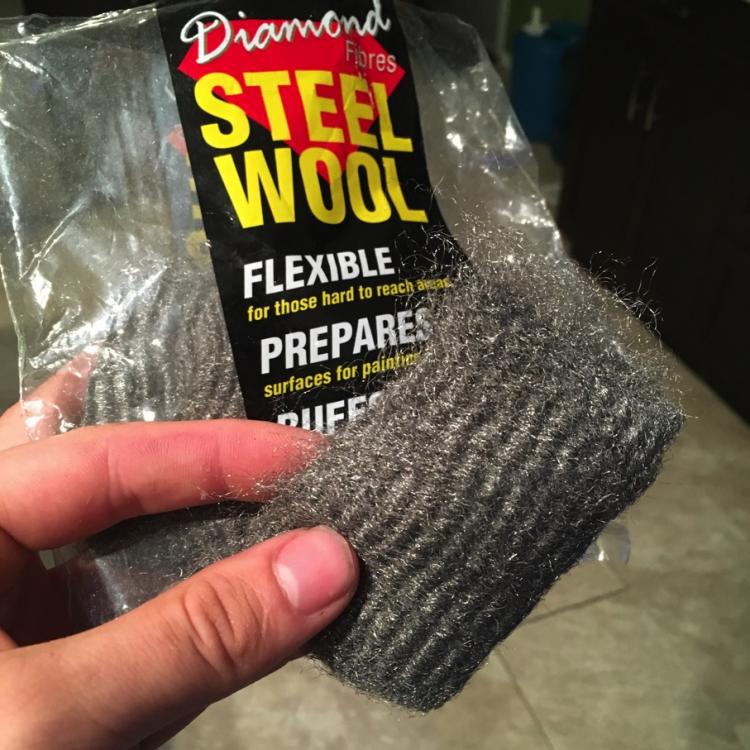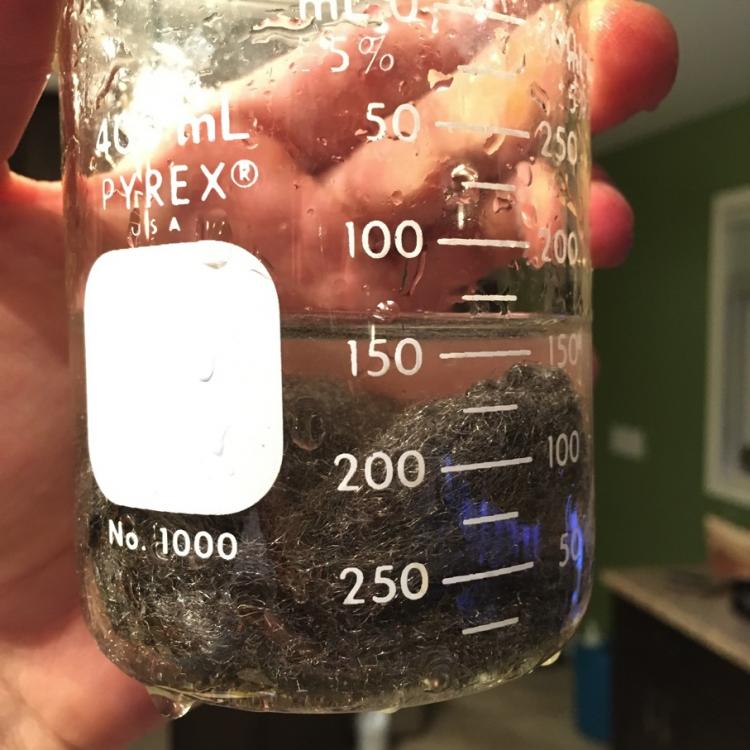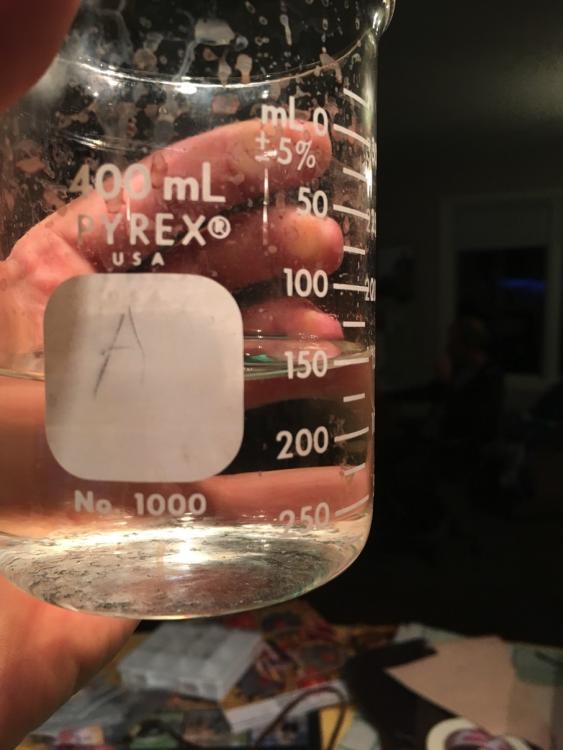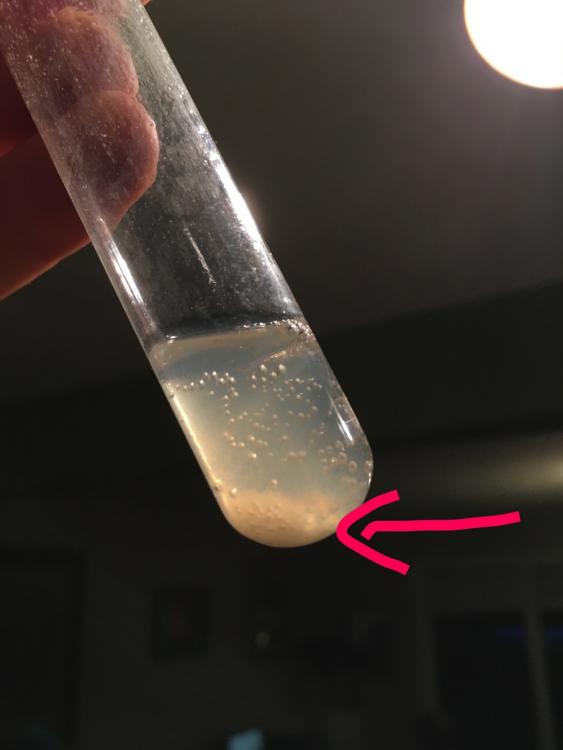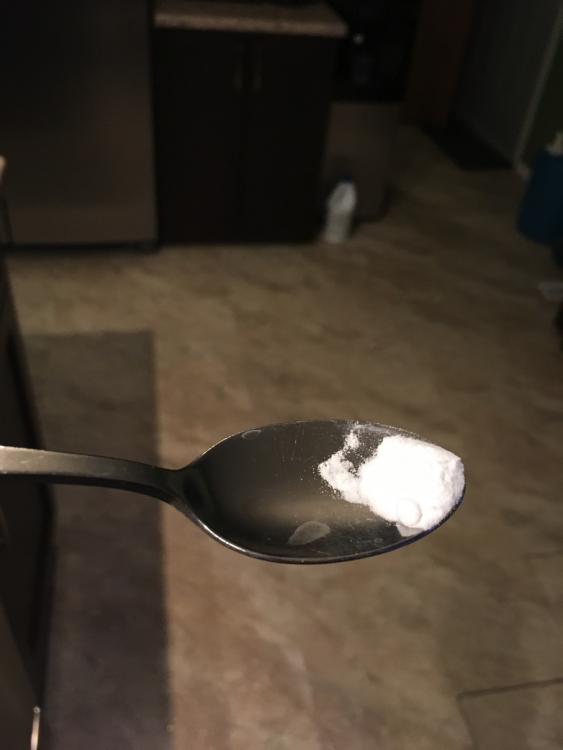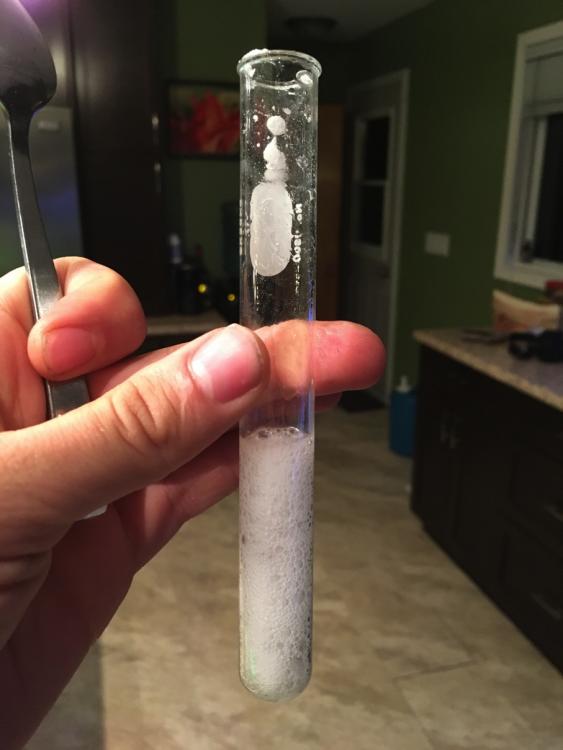Search the Community
Showing results for tags 'black dye'.
-
My all in one guide to Vinegaroon Hey everyone. I’ve been lurking around these forums for a while now and haven’t posted much, so I thought I’d finally make a contribution. I’m going to University for a Chemistry degree, and surprisingly some of the things I’ve been learning in my labs are actually applicable to my leatherwork! I thought I'd write up some of my observations and experiments with vinegarroon, to try and help shed some light on what is actually going on in the reaction. Please, read through and share any knowledge you have working with this stuff! (I know this is a lot. I was bored just typing it. You can skip to the bottom if you don't have time to read it all) Background Vinegaroon, or ‘roon, is a homemade black ‘dye’ that has been used by leatherworkers for centuries. It is also used by woodworkers to ‘ebonize’ wood, and was used since the 5th century as ink, called ‘iron gall ink’. It is not actually a dye, but a reaction between ferric acetate and the tannins that naturally occur in leather and wood. Tannins content varies between hardwoods and softwoods, and can be boosted by brewing a strong black tea and wiping it on the wood. I assume that this is also true of leathers. I have a few junky tandy's sides that are pale in appearance, and they seem to be low on tannins because roon has less of an effect on them. ‘Roon is used by many leather and wood workers but understood by few. It can be very useful alternative to commercial black dye in areas where dye is unavailable, too costly, or undesired because of environmental reasons. Also, because it is fundamentally different than other dyes, it will not bleed or crock (rub off) onto fabric. Pros: -easy to make with household materials -available in places where dye is not, or shipping is too expensive -nearly free -does not bleed or crock like other black dyes Cons: -often does not make a deep enough black colour without lots of neatsfoot oil added afterwards -can make your product smell like vinegar -acidic nature can cause issues with metal hardware in contact with the leather, might also degrade then leather after long periods of time Typical Recipe: (not recommended by me) Put some old rusty nails into a jar of vinegar and let it sit for a week, or a month. Filter it through cheesecloth and wipe it on your leather. This produces a nasty, smelly mixture of a whole bunch of iron complexes and compounds. The active ingredient, iron acetate, is in there, but along with a whole bunch of other junk you don’t need. It doesn’t have to be this way. With some chemistry and a little bit of research into the mechanism here, I’ve made a crystal clear, mostly odourless solution that only takes half a day to make. How I did it: I bought fine steel wool from the dollar store, which came in small bats. Any steel or iron will do, but fine steel wool has the greatest surface area so it will react the fastest. Metal shavings/powder would also work, but I’d think they would just clump on the bottom of the jar and prevent the vinegar from reaching the bottom layers. I washed one bat in soapy water to remove any oils left over from manufacturing. Some people have used acetone, which would work well, but seems a bit over the top when soap is cheaper. I pulled it apart and placed it in a beaker of regular vinegar, so that all the wool was submerged. You don’t need very much steel wool at all, even a quarter of the amount I used would be enough. The amount of metal actually being dissolved is in the order of milligrams or even micrograms. You probably shouldn’t keep a lid on it, because you are producing gas in the reaction. After a few hours, small bubbles form on the steel wool, causing it to rise to the top of the solution. I would mix it gently to dislodge the bubbles and keep it submerged. Every few hours I would use an eye dropper (so that I didn’t have to pour it out) to take a bit of the solution and test it on some leather. The darkening effect increased slowly over time until full strength was reached after about 12 hours. Still, I left the wool in there for 2 days to see if it got any stronger. Next time I won’t leave it in so long. After 2 days, I removed the wool. Since none of the wool was ever exposed to the air above, there was no rust in the beaker and I was left with a nice clear solution that didn’t smell much worse than straight vinegar. This is my vinegaroon solution. It turns leather black, is fairly stable, and is still acidic. The final product: a clear, nearly odourless solution of vinegaroon. Neutralization (optional): Next, I tried to neutralize the solution with baking soda to see if that changed the effectiveness of it at all. I took a small test tube of the ‘roon solution and put a spoon tip of baking soda in it. Obviously this will make it fizz up like your kid’s science fair volcanoe project, so I added it slowly. I didn’t have any pH paper to test the acidity so what I did was add an excess of baking soda (seen on the bottom of the tube), and then re-added the acidic ‘roon solution dropwise until there was no excess left. These images show the neutralization process, if pH paper is unavailable. A base (sodium bicarbonate/baking soda) is added in excess, which is seen in the bottom of the test tube by the red arrow. Then, the acidic vinegaroon solution is re-added slowly until this excess base disappears. The resulting solution is assumed to be neutral. This neutralized roon solution has the exact same reaction with the leather as the acidic solution. However, it was not as stable. After a hours sitting or a few minutes shaking, the solution turned into a cloudy grey-orange sludge. This is because the oxygen in the air oxidized the Fe2+ ions into Fe3+ ions, which are not soluble and have a rusty colour. Neutralized roon is good for immediate use, but turns nasty after a while What is happening? (skip this section if you don’t like chemistry) The iron is dissolved by the acetic acid and becomes a free-floating iron ion, in the +2 oxidation state, called Fe2+ or Iron(II). Hydrogen gas is produced in the dissolution process but in such small amounts that there is nothing to worry about. This ion is colourless and soluble in water, which is what we want. Furthermore, when this ion is in an acidic solution, like vinegar, it is relatively stable. Some of the ions complex with the acetate, which further increases its stability. When this mixture is applied to the leather, the iron ions interact with the tannins to form an iron-tannin complex, which is black. Oxygen messes with this system. Obviously there is oxygen in the atmosphere and dissolved in your solution, and this can oxidize the iron ions – it will take them from the 2+ state to the 3+ state. Fe3+ or iron(III) is NOT what we want, because it is orange and gross and not soluble in water. If this forms, it creates an orange/brown powdery solid that sinks to the bottom of the jar. To prevent the oxidation of the iron in solution, we need to keep the pH LOW and keep the oxygen out of the system as much as possible – by not pouring or shaking the solution. Now, the acidity of the solution is what keeps it stable – I’m assuming that you could store vinegaroon for a few weeks or months if you kept a lid on it. But the acidity is also what makes it dangerous for using with metal hardware. So what I’ve done is neutralized the solution with baking soda, just before applying it to the leather. The neutralized solution is just as effective, but noticeably less stable. The nice clear solution will turn orange overnight if untouched, or in seconds if shaken. So there you have it. Here’s a summary of what you SHOULD do: -keep the oxygen out of the system. Oxygen is your worst enemy, and turns this pure, clear solution of iron acetate into a sludgy, brown, stanky mess. -keep the solution acidic until you need to use it, then neutralize it if you need to before applying -use steel wool, as it has way more surface area than the same mass of solid iron And what you SHOULDN’T do: -don’t use rusty metal. It wouldn’t make a huge difference, it would just be introducing iron(III) into the solution which you don’t want. -don’t stir vigorously or pour the solution if possible -don’t use lots of metal, cause you only needs a little -don’t wait for a week, cause full strength is reached in less than a day -don’t put a lid on it until you’ve removed the iron, cause you’re building up gas in that jar -don’t worry about anything exploding either, there’s not that much gas -don’t filter it! Pouring it would introduce too much oxygen into the system. If you have stuff that you need to remove, it would be better to suck the ‘roon out with a turkey baster or something. What you could do differently than me: -using stronger vinegar, ie pickling vinegar, would speed up the reaction slightly and probably produce better results, since the pH would stay lower. Normal vinegar, however, is fine for most uses. -If you want to ensure that you have neutralized the solution, or gain a greater insight into the reaction process, pH paper would be very useful. -The solution could be neutralized with other bases, I only used baking soda because it was within an arms reach of the vinegar. Using sodium hydroxide, for example, wouldn’t cause it to bubble so much. -The solution can also be heated to speed the reaction, although I personally wouldn’t bother -Perhaps the best thing you could do is to calculate just how much iron will react with the vinegar and use slightly less than that amount of steel, to ensure that you have vinegar in excess. This will keep the pH from rising as vinegar is consumed by the reaction. This could be calculated stoichiometrically, or possibly by weighing accurately the mass of steel wool before and after to find out how much was consumed. I would assume that it wouldn’t be very much at all. Resources: The main reason why I found it so hard to find information on this reaction is because I initially had no idea what to search for. “vinegaroon” only can up with a few result, and most of them were not scientific explanations. I soon found out that it is more commonly used for “ebonizing wood” and that yielded a few more results. Finally I came across some scientific papers for Iron-acetate and iron-tannin complexes. Here are links to most of the pages I found helpful in my search: http://chemistry.stackexchange.com/questions/35351/iron-chemistry-acetates-for-ebonizing-wood http://chemistry.stackexchange.com/questions/5027/how-does-the-mordant-ferric-acetate-interact-with-tannins-when-ebonizing-wood https://en.wikipedia.org/wiki/Iron_gall_ink https://pubs.usgs.gov/wsp/1459d/report.pdf Thanks a lot for reading that, if you made it all the way through! Ask me any questions or share your experiences with roon below!
- 54 replies
-
- vinegaroon
- roon
- (and 10 more)
-
I thought i had it under control, but I am in desperate need of help. Its a cardholder. I dyed it black (sprite-based dye, 3 coats), let it dry over night, buff it, applied satin sheen (two coats) and buffed it (no dye is coming of). But, when I buff it with a wet cloth, the dye comes off. I cant have the dye coming off, it will ruing the clothes. What I am doing wrong? What I am to do? How can I seal this? I have leather grease, satin sheen and Resolene at my disposal. (I try to avoid resolene due to the shine it gives) This is my first real commission and I really want it to be perfect, and I am suppose to ship it out tomorrow! Any help is deeply appreciated! /Nicklas
-
Hey all! I'm looking for advice on a problem I've been having for awhile. Whether I use black dye (water or oil based), antiquing, edge coat, or whatever, my black doesn't stay black. When I put a top protective coat on (resolene, super shene, satin shene, etc), the black wipes off leaving brown behind. On this specific piece I tried one technique that didn't work and subsequently tried a second one that hasn't failed me too badly in the past. Well, this time it did fail. All my attempts (including my last one of over-dyeing the entire project) went bust. I personally like the rustic look I wound up with, but it's not what my customer ordered. So, two questions: 1. How do you keep your black vibrantly black? What products or techniques work for you? 2. Any ideas on how to fix this specific piece? Thanks, Miranda
- 22 replies
-
- black dye
- black antique
-
(and 1 more)
Tagged with:
-
I have a problem and am at my wits’ end, so I figured I’d come ask you intelligent and experienced people for advice. :-) I apologize if this is long-winded. I have designed a cuff bracelet that fits various wrist sizes because it is slotted rather than clasped. I made a prototype that I have worn for months and months to “test drive” it, and it’s holding up great and gets a lot of compliments. But now that I’m trying to make it in other colors to sell, black in particular is giving me trouble. (By the way, I am using 7-oz. natural veg-tanned leather from Wickett & Craig.) Mine is dyed Fiebing’s “LIght Brown” (which is actually a lovely mottled dark brown) sealed with full-strength Resolene, and it’s doing fine. I’ve had a couple since then crack beside one of the slots — that could be due to overcutting the slot and/or not conditioning the leather. So I’ve started using leather conditioner after dyeing, and also using a punch tool to cut the slots instead of a hole punch and utility knife, and I haven't seen the cracking problem again so far. So here is the current problem… The several black ones that I’ve made recently have not held up to a stress test — the finish appears to rub off at the contact points. (See the picture for an example.) I haven’t made many colors, but my brown one doesn’t do this. (Of course, it’s possible that it DOES do this but I just can’t tell because the color behaves differently.) I have a dark blue one that has a similar issue to the black (though not quite as bad). It didn’t get conditioner, so I doubt it’s the conditioner causing the problem. I have tried different dyes (Fiebing’s Pro Oil Dye, and Angelus Jet Black). I have tried Black Resolene (which has had the WORST results for this), as well as clear Resolene (both at full strength). I have tried with and without additional finish after the Resolene (Eco-Flo Satin Shene, or Fiebing’s Leather Balm with Atom Wax). I have tried PRAYER. :-) I have used up a lot of time and leather. I need a durable and flexible finish that will prevent dye bleed when the person wearing the bracelet sweats, and that will not rub off at contact points. I suspect this is possible, as belt-makers seem to do okay… What finish do they use (or is it a certain kind of pre-dyed leather)? Should I be cutting the Resolene with water 50/50 (as I have seen suggested elsewhere in the forums), and would it solve the problem? Any help will be greatly appreciated!
- 15 replies
-
- finish
- rubbing off
-
(and 3 more)
Tagged with:
-
Hello all, my name is Brandon and I am still a newbie. I have a problem that I would like to have some help with. I was asked to make a black leather skeet pouch. The pouch came out great first of all. I might have done everything wrong though. I cut out all the pieces and punched the stitching holes. I laced it up with a double loop stitch and then I dyed it. The first coat made it look purple and you could still see some of the raw leather peaking through so I decided a second coat would be good. I read somewhere on here that you dye your project after you are done stitching, so thats what I did. Normally I only use brown dyes and have never had to wipe off any excess. I just put on the coat of Carr and Day and Martin Belvoir leather balsam. So this is what I did with the black oil dye. Unfortunately after applying it with the tan sponge it comes with, it was totally black. This worried me since the skeet pouch will be on a belt and rubbing off on this guys pants. So I got out some rags and started buffing the pouch................well I'm about 15 rags in and it is still just coming off. I don't know if it is because the balsam is releasing it or it just has that much extra dye on it. Please give me some advice. Should I just keep buffing and use a different sealer?



